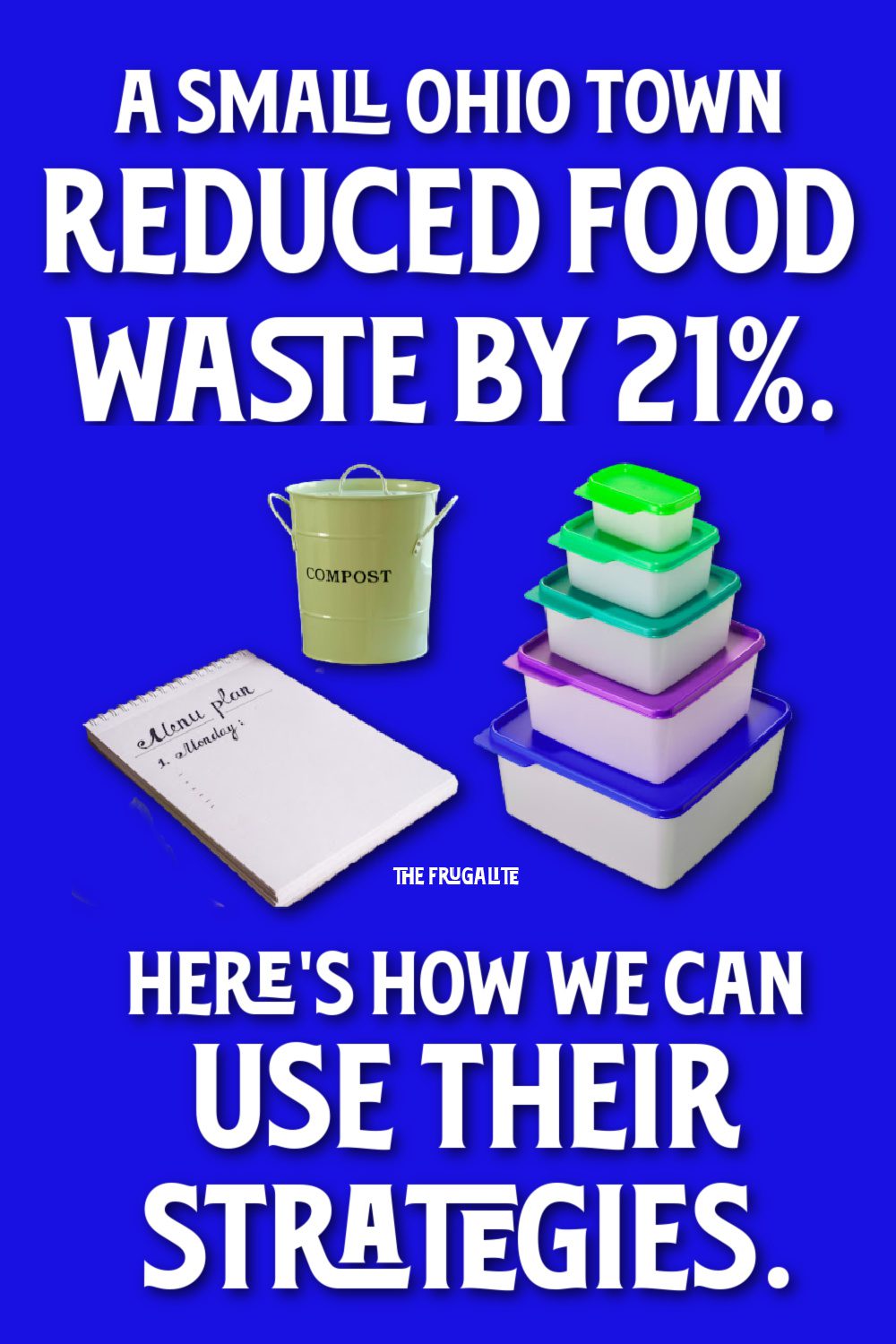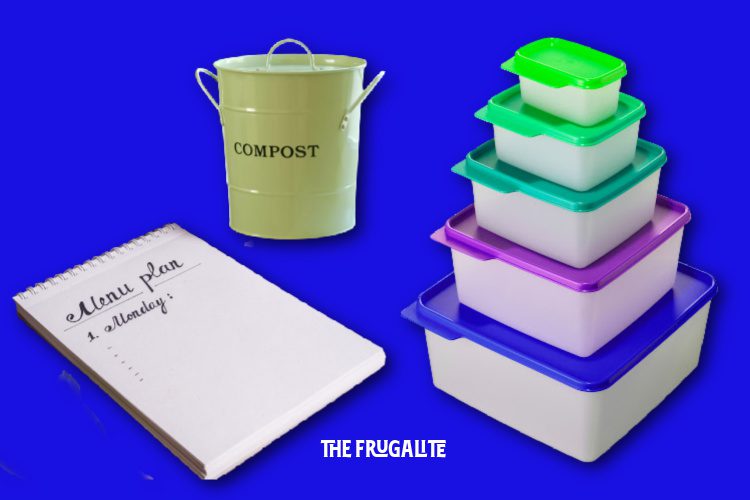(Psst: The FTC wants me to remind you that this website contains affiliate links. That means if you make a purchase from a link you click on, I might receive a small commission. This does not increase the price you’ll pay for that item nor does it decrease the awesomeness of the item. ~ Daisy)
By the author of The Ultimate Guide to Frugal Living and The Flat Broke Cookbook
How many times have you yelled at your family about leftovers? How many times have you found said leftovers turning into a science project hidden behind the milk? How often do you have to throw away food you simply forgot you bought, only to discover it once you went to investigate a suspicious smell in the refrigerator?
A small town in Ohio tackled these problems and more using several strategies to reduce food waste by more than 20%. Considering that Americans throw away a full one-third of our food every year, this is a significant amount. And with the price of groceries, salvaging a few extra meals is a gift.
When the Solid Waste Authority of Central Ohio, or SWACO, became concerned about the longevity of their landfill, they began to look at ways to address the problem. The most obvious place to focus their attention was on food waste. Not only did that affect every single family in the community, but it was a place where everyone could make a difference. They partnered with GT Environmental, a local consulting company, to address the issue. In 2021, the program saw 51% of the area’s waste diverted from the landfill.
While SWACO’s goal was better waste management, in a world with food shortages, massive inflation, and tight budgets, their findings can help all of us make our food dollars go further. And if it’s better for the environment, too, then win-win.
Let’s take a look at the strategies used in Upper Arlington, Ohio, to cut food waste and see how we can apply them to our own households.
Calculate how much money you’re wasting.
The first strategy used by SWACO was cold, hard cash.
“The way to really get people’s attention in the Midwest and Ohio is through pocketbook issues,” said Ty Marsh, who served as the agency’s executive director until last April. “We’ve got to convince people that this is good for them.” So the campaign emphasized hard costs: the $1,500 the average family in central Ohio spends each year on food they don’t eat, the 22 million gallons of gas used annually to transport food that’s thrown away.
Look at your own food waste and make a calculation. How much do you throw away every week? How often do you end up eating out at the last minute because the food you were planning to eat spoiled in your refrigerator before you got to it?
Don’t just look at the quantity of food. Look at it in terms of dollars and cents. If you’re trying to get your family on board with your efforts, post the amounts on the fridge, and at the end of the month, look at your running total. This gives you a specific target to beat.
Focus on solutions instead of problems
Once they made the public aware of the problem, the energy went toward solutions.
SWACO also shared tips: Shop with a list, create meal plans, freeze leftovers. Some residents even received offers of free Bluapple pods, which help produce stay fresh for longer, and liners and bins to make composting easier.
Of course, as seasoned Frugalites, we’ve got solutions out the wazoo. Here are some articles if you need a refresher.
- 6 Frugal and Delicious Ways to Repurpose Leftovers
- Frugal Food Prep Keeps You On-Budget
- 3 Ways to Preserve Your Holiday Leftovers and Add Them to Your Pantry
- What to Do with Last Day of Sale Groceries
By dealing with leftovers immediately, you’ll be able to prevent them from spoiling. By meal prep and planning, you’ll no longer have ingredients that linger too long.
Compost what you can.
Of course, we’ll probably never manage to eat every single bite and never ever throw anything away. That’s why composting is key.
SWACO offered compost bins to locals and also provided education about composting.
We Frugalites are already aware that composting is a great way to turn potential trash into garden gold. Go here to learn how to make a thrifty compost bin and what you can compost. As well, if you happen to have chickens or other livestock, they’ll generally feast on food that’s a bit too far gone for human consumption.
Get the kids on board.
Perhaps the biggest part of SWACO’s strategy was their focus on the next generation.
Though the youngest students may not have understood why they were separating their waste, most would by the time they reached graduation. Much of that is thanks to Ekta Chabria, a special-education teacher who was one of the early proponents of Horizon’s composting program. Her efforts received a boost in 2018 when SWACO gave the Hilliard City Schools district a $25,000 composting grant. The following school year, Hilliard’s 14 elementary schools cut their trash pickups by 30 percent and recycling pickups by 50 percent, saving the district $22,000. They also diverted 100 tons of food, at least five school buses’ worth of waste, from the landfill.
Kids were taken to have a tour of the landfill and learn about the effects of all the garbage on their local community. Then they were provided with actionable solutions such as recycling and composting.
The elementary school in Upper Arlington works with the children daily to teach them about managing recycling, composting, and waste.
Instead of nondescript trash cans lining the room, six sit in the center, an unavoidable focal point.
One Thursday, Tobias, a first grader with blond hair, glasses and a T-shirt emblazoned with jet planes, approached the six-bin command station. He removed a hot dog bun from his tray and eyed the aide standing above him.
“Where do you think that goes?” she asked. Tobias held the bun tentatively over the can labeled “LANDFILL.” The aide gave a slight shake of her head. He moved to the next one, “RECYCLING.” No dice. Finally, Tobias waved the bun over the last option: “COMPOST.”
“Yes!” the aide said enthusiastically. “It’s food, so it can go in the compost, remember?” Tobias just smiled and relinquished his bun.
Tray by tray, the process was repeated. Tiny hands squeezed the dregs of milk cartons and juice boxes into the compost bin, then tossed the empty containers into the recycling bin. The students deliberated over the placement of carrots and chicken nuggets (compost), yogurt lids (landfill) and napkins (a tricky one: compost). They put unopened cheese sticks and applesauce onto a “share table” for others to take.
Once the kids were on board, they took the lessons home to their parents, who supported their enthusiasm.
Our parents tried this with the “starving children in Africa” story, but I think SWACO’s way is more persuasive than guilt. Can you get your children on board with your food waste reduction plan? Think of ways you can get them to take ownership of it.
- Older kids could repackage leftovers into lunch portions
- Younger ones could be in “control” of your home compost program by scraping plates and carrying the waste to the bin
- Consider a family reward based on the reduction of food waste. For example, if you have a week with no waste, a family movie night could take place.
The power of children is often underestimated when you’re working on the family budget. But they can be enthusiastic advocates and your budget will be all the better for it. I don’t know about you, but my kiddos were little generals when assigned tasks like this, especially when they understood the reasons why we were doing it.
What do you think about these strategies?
Are you working on reducing food waste this year? If so, what strategies are you using? Do you think any of the ideas from Upper Arlington, Ohio could be applied to your household?
Let’s discuss it in the comments.
About Daisy
Daisy Luther is a coffee-swigging, adventure-seeking, globe-trotting blogger. She is the founder and publisher of three websites. 1) The Organic Prepper, which is about current events, preparedness, self-reliance, and the pursuit of liberty; 2) The Frugalite, a website with thrifty tips and solutions to help people get a handle on their personal finances without feeling deprived; and 3) PreppersDailyNews.com, an aggregate site where you can find links to all the most important news for those who wish to be prepared. Her work is widely republished across alternative media and she has appeared in many interviews.
Daisy is the best-selling author of 5 traditionally published books, 12 self-published books, and runs a small digital publishing company with PDF guides, printables, and courses at SelfRelianceand Survival.com You can find her on Facebook, Pinterest, Gab, MeWe, Parler, Instagram, and Twitter.












6 thoughts on “A Small Ohio Town Reduced Food Waste by 21%. We Can Use Their Strategies to Make Food Go Further.”
Impressive. When I taught school, I was appalled at the lunchroom waste. What a great lesson plan!
The town forgot one thing: a vet friend of my father’s always said that table scraps can be fed to dogs to supplement dried dog food.
This is great! Thank you for this article.
Public schools are not all bad. Kids are (usually) eager learners. The amount of food wasted is truly appalling whether it is good times or bad. Some of us come from generations of “we don’t waste food”. I put what I know I can eat on my plate – I can always get more/find something else to eat IF I’m still hungry (after waiting a bit). When I eat out, I order items I know I can reheat at home later.
Our rural school used to have farmers pick up the food scrap/”waste” for their hogs. Another place there is a lot of food waste is nursing homes. Yes, the law that states how much a resident should get is good as some homes did not adequately feed their residents. But there has to be a better IMHO but I don’t know what it is.
“A Small Ohio Town Reduced Food Waste by 21%. We Can Use Their Strategies to Make Food Go Further.”
We meal plan. I have nearly zero food waste.
Having the ‘share table’ would also indicate what foods the kids don’t eat/like. So provide something else – of course fitting in with the directives of school lunch. Save waste, provide better nutrition
I suspect the “lions” share table is for items packed in sack lunches kids brought to school as likely pre-packaged. But you’re correct – if a boatload of one item offered for hot lunch hits the table, perhaps don’t order again. However some schools don’t have total control over what they can/can’t order/receive for school lunch.